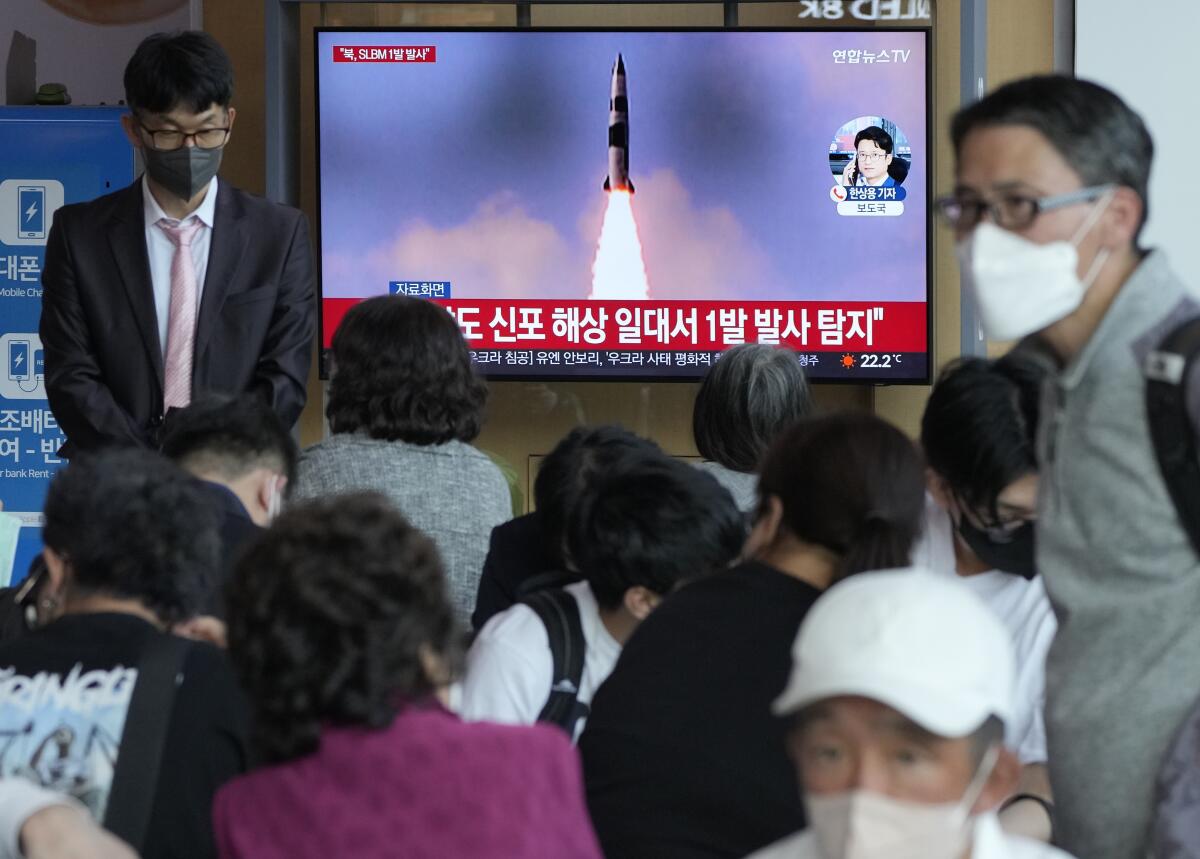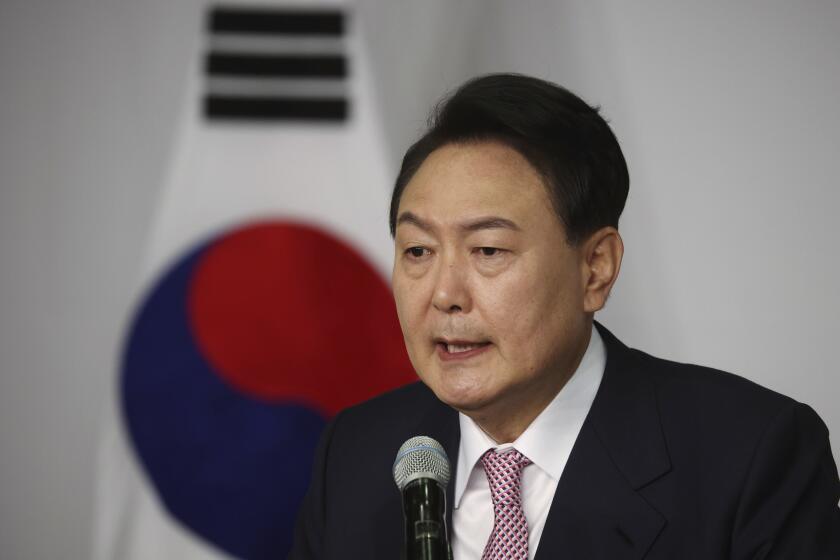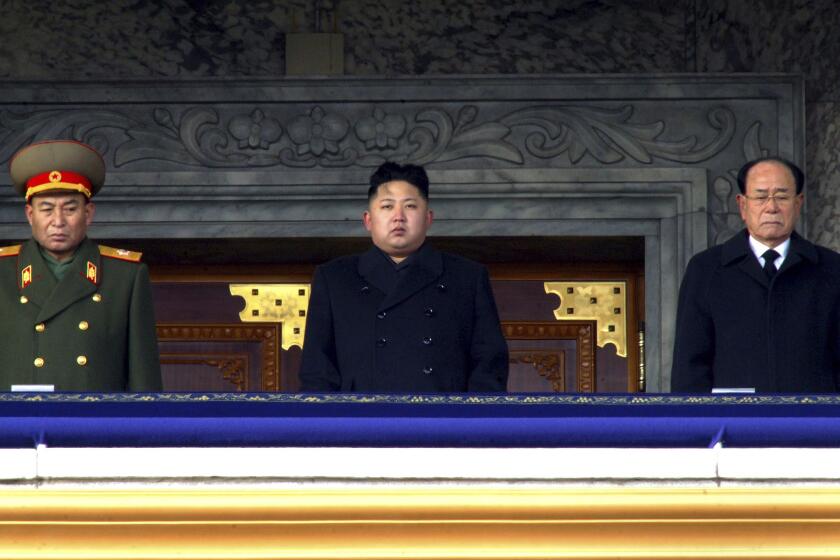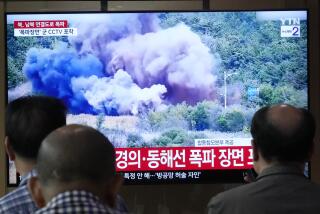North Korea test-fired missile from submarine, South Korea says

- Share via
SEOUL — North Korea flight-tested a ballistic missile that was probably fired from a submarine on Saturday, South Korea’s military said, continuing a provocative streak in weapons demonstrations that may culminate with a nuclear test in the coming weeks or months.
South Korea’s Joint Chiefs of Staff said the launch occurred from waters near the eastern port city of Sinpo, where North Korea has a major shipyard building submarines. It said the short-range missile flew 372 miles at a maximum altitude of 37 miles, but it didn’t immediately provide details about the submarine that would have been involved in the launch.
The U.S. military’s Indo-Pacific Command said in a statement that while the launch did not pose an immediate threat to U.S. personnel or territory, or to U.S. allies, it “highlights the destabilizing impact of the DPRK’s [Democratic People’s Republic of Korea’s] illicit weapons program. The U.S. commitment to the defense of the Republic of Korea and Japan remains ironclad.”
Japanese Defense Minister Nobu Kishi told reporters that the missile fell outside Japan’s exclusive economic zone and that no damage to aircraft or vessels was reported.
South Korea’s national security director Suh Hoon and other senior officials during an emergency meeting denounced the launch and urged North Korea to return to long-stalled talks aimed at defusing the nuclear standoff, Seoul’s presidential office said.
It was apparently North Korea’s first demonstration of a submarine-launched ballistic missile system since October, when it fired a new short-range missile from the 8.24 Yongung — its only known submarine capable of launching a missile. The October underwater launch was the North’s first in two years.
The South Korean conservative president-elect is sure to be tested early on as North Korea rattles saber over nuclear weapons.
On Wednesday, the South Korean and Japanese militaries detected a suspected ballistic missile fired from near the capital, Pyongyang. Both exercises come ahead of the inauguration on Tuesday of South Korean President-elect Yoon Suk-yeol, who has vowed to take a tougher approach over the North’s nuclear ambitions.
Yoon’s office said in a statement that his government will pursue “actual deterrence ability” against the North’s nuclear and missile threat, but didn’t specify how. Yoon has vowed to strengthen South Korea’s defense in conjunction with its alliance with the United States, which he said would include enhancing missile striking capabilities.
So far this year, North Korea has fired missiles 15 times. They include the country’s first test of an intercontinental ballistic missile since 2017 in March that demonstrated a potential range to reach the entirety of the U.S. mainland.
North Korea has been clearly exploiting a favorable environment to push forward its weapons program with the U.N. Security Council divided and effectively paralyzed over Russia’s war on Ukraine. The unusually fast pace in testing activity underscores a brinkmanship aimed at forcing the United States to accept
the idea of North Korea as a nuclear power and remove crippling sanctions, experts say.
There are also signs that North Korea is restoring tunnels at a nuclear testing ground where it had conducted its sixth and last nuclear test in September 2017, in possible preparations for another explosive test. Analysts say Pyongyang could use another nuclear test to claim it can now build small nuclear warheads for its expanding range of shorter-range weapons threatening South Korea and Japan, or put a cluster of bombs on a multi-warhead ICBM.
Jalina Porter, the U.S. State Department’s deputy spokesperson, said during a briefing Friday that the United States assesses that North Korea could be ready to conduct a nuclear test at its Punggye-ri test site as early as this month.
North Korean leader Kim Jong Un reaches 10 years in power
North Korean leader Kim Jong Un has punctuated his recent missile tests with statements warning that his nation could proactively use its nuclear weapons if threatened or provoked. Experts say such rhetoric possibly portends an escalatory nuclear doctrine that would create greater concerns for South Korea and Japan.
Kim made one of those statements during an
April 25 parade in Pyongyang, where he showcased the most notable weapons in his military nuclear program, including ICBMs and what appeared to be a new type of missile designed to be fired from submarines that could be larger than previous models.
North Korea’s “submarine technology probably remains short of being able to stay at sea for extended periods while avoiding detection. But the ability to launch ballistic missiles from a submarine would further complicate missions to neutralize and defend against North Korea’s nuclear forces,” said Leif-Eric Easley, a professor of international studies at Seoul’s Ewha university.
He said Kim’s government appears to be preparing to test a miniaturized nuclear device that it can use to arm its submarine-launched or tactical missiles, and multiple warheads on its ICBMs.
North Korea has been pushing hard to acquire an ability to fire nuclear-armed missiles from submarines.
Ballistic missile submarines would add a new maritime threat to its growing collection of solid-fuel weapons fired from land vehicles, which are being developed with an apparent aim to overwhelm missile defense systems in South Korea and Japan.
North Korea in recent years has been developing and testing a family of missiles named Pukguksong, which are designed to be fired from submarines or land vehicles. Still, experts say the heavily sanctioned nation would need considerably more time, resources and major technological improvements to build at least several submarines that could travel quietly in seas and reliably execute strikes.
The South Korean and Japanese militaries said the North Korean missile fired on Wednesday traveled about 310 miles at a maximum altitude of 500 miles. North Korean state media have yet to comment on that test.
Associated Press writer Yuri Kageyama in Tokyo contributed to this report.
More to Read
Sign up for Essential California
The most important California stories and recommendations in your inbox every morning.
You may occasionally receive promotional content from the Los Angeles Times.












